Vibration Sensor Market Size
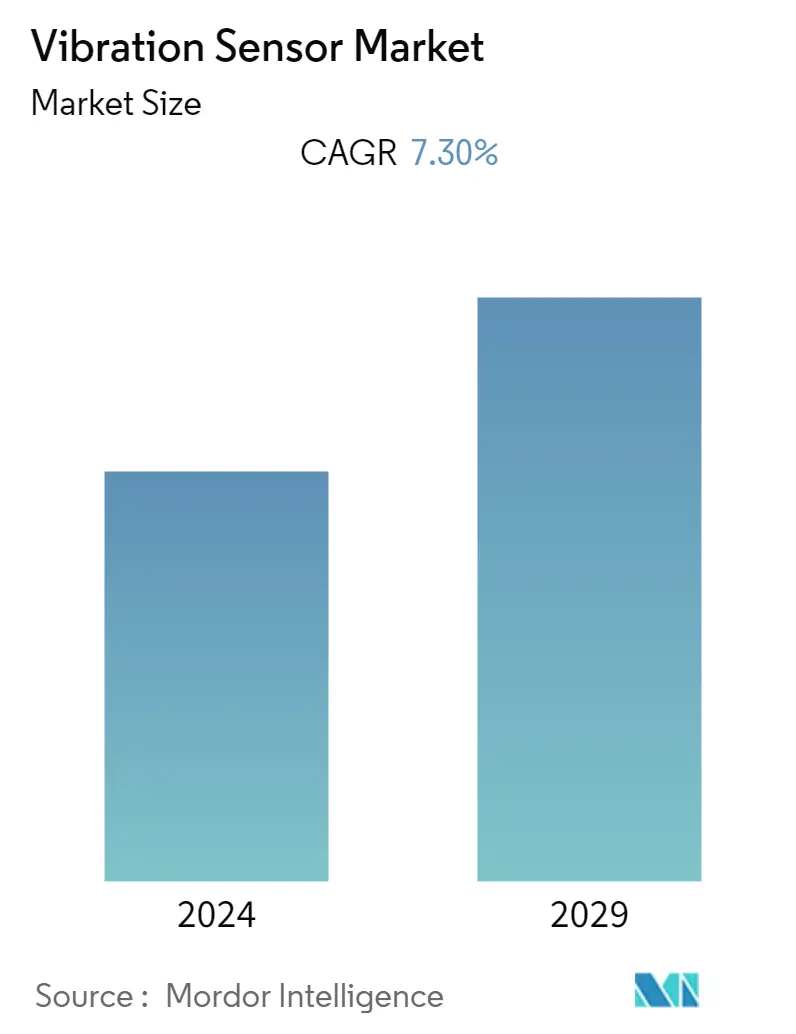
| Study Period | 2019 - 2029 |
| Base Year For Estimation | 2023 |
| CAGR | 7.30 % |
| Fastest Growing Market | Asia Pacific |
| Largest Market | North America |
| Market Concentration | Low |
Major Players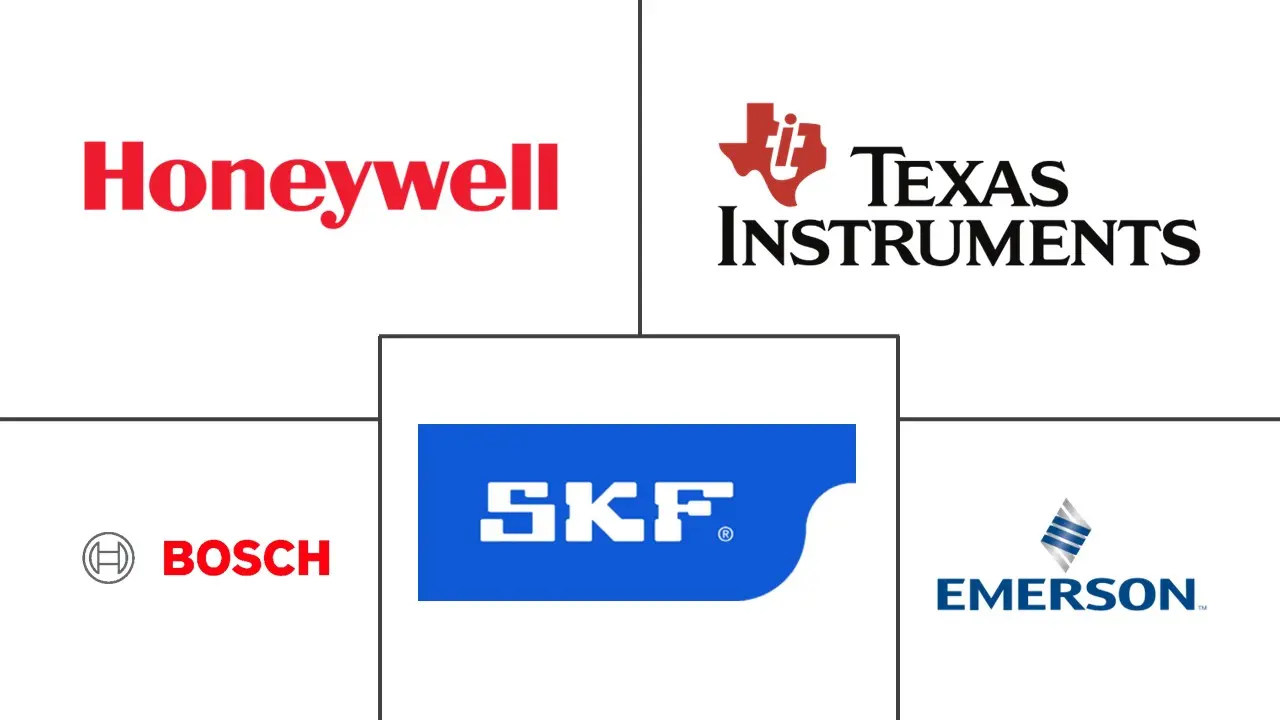
*Disclaimer: Major Players sorted in no particular order |
Need a report that reflects how COVID-19 has impacted this market and its growth?
Vibration Sensor Market Analysis
The vibration Sensor Market is expected to register a CAGR of 7.3% during the forecast period. Monitoring and analyzing vibrations of machines or other critical equipment in various industrial sectors have become a very crucial part of the predictive maintenance program. Typical applications demand vibration measurements in the horizontal, vertical, and axial directions on both the inboard and outboard motor bearings.
- In an increasingly competitive industrial market, where new features are required to produce ''smarter'' tools, monitoring the condition of various components has become a fundamental need. This is expected to boost the demand for vibration sensors over the forecast period.
- With the advent of industry 4.0, organizations have started being more bent on automation and predictive maintenance that allows them to prematurely detect the wear and tear in the machines and equipment. This is expected to boost the adoption of such sensors over the forecast period.
- In March 2022, Flusso announced the world's smallest air velocity sensor. The FLS122 has a footprint of only 3.5 by 3.5 mm, making it 80% smaller than today's smallest competitive device. Flusso's FLS122 sensor was designed specifically for board-mounted air velocity measurements for thermal management and filter monitoring in some of the most space-constrained and challenging environments.
- In addition, the demand for vibration sensors has been rising for the last few years, and compatibility concerns, especially with old equipment, have been identified as major challenges affecting the market.
- Furthermore, in March 2022, Spectris plc, a supplier of high-tech precision instruments, announced the acquisition of Dytran Instruments, a leading designer and manufacturer of piezo-electric and MEMS-based accelerometers and sensors. The USD 82 million deal will enable both companies to leverage complementary capabilities to improve customer offerings and accelerate product development.
- The increasing adoption of smart devices, such as smartphones, wearables, smart appliances, and implantable or ingestible medical devices, among others that use accelerometers, is expected to drive the growth of the vibration sensors market over the forecast period.
- For instance, in March 2022, Samsung launched the new Galaxy A-series Smartphone. An octa-core processor powers Samsung Galaxy A53 5G. It has a 120 Hz refresh rate and 6.50-inch touchscreen display, offering a resolution of 10802400 pixels at a pixel density of 407 pixels per inch. In Addition, Connectivity options on the Samsung Galaxy A53 5G include Wi-Fi 802.11 a/b/g/n/ac, GPS, Bluetooth v5.10, NFC, USB Type-C, 3G, 4G, and 5G. Sensors on the phone include an accelerometer, ambient light sensor, compass/ magnetometer, gyroscope, proximity sensor, and in-display fingerprint sensor.
- Vibration gyroscope sensors are also widely adopted for electronic stability control systems of vehicles, car navigation systems, motion-sensing for mobile games, camera-shake detection systems in digital cameras, robotic systems, radio-controlled helicopters, etc. In the last few years, smartphones have witnessed MEMS gyroscopes' great success, owing to their low-cost, miniature size, and lightweight.
- Furthermore, owing to the COVID-19 outbreak, the global supply chain and demand for multiple products have experienced disruption. Moreover, due to the production shutdown in China, numerous industries have observed a supply shortage of various products. However, market vendors are trying to provide services to enterprises, which is helping them get revenues.
Vibration Sensor Market Trends
This section covers the major market trends shaping the Vibration Sensor Market according to our research experts:
Aerospace & Defense End User to Hold Significant Share
- Increased situational awareness to drive operations, cost-effective maintenance, and asset utilization are some of the key factors driving the demand for aircraft health monitoring systems.
- Moreover, in March 2021, the National Institute of Technology (NIST) researchers developed a new type of accelerometer based on opting mechanical and lasers principles. This sensor consists of a pair of silicon chips and could find use in spacecraft and aircraft, self-driving cars, tablets, and smartphones, which will further drive the market growth.
- The passenger traffic in Asia and other major aviation markets, such as the United Kingdom, Europe, and Germany, has witnessed growth in terms of the number of passengers and aircraft movements, which is expected to drive the market during the forecast period.
- For instance, according to Boeing, the market size of India's commercial aviation services industry is expected to witness 3.7 trillion U.S. dollars by 2040, creating demand for an additional 2,200 new commercial aircraft in the next 20 years. As a result, the expanding airline industry is expected to increase the demand for vibration sensors, driving the market during the forecast period.
- Turbine engine failures are the primary cause of mechanical failures, increasing costs; hence, users are increasingly turning to prognostic health management (PHM) systems to prevent these losses and reduce maintenance costs. As vibration is the most common health monitoring parameter in the aerospace engine industry, the development of PHM systems is likely to directly impact the growth of vibration sensors.
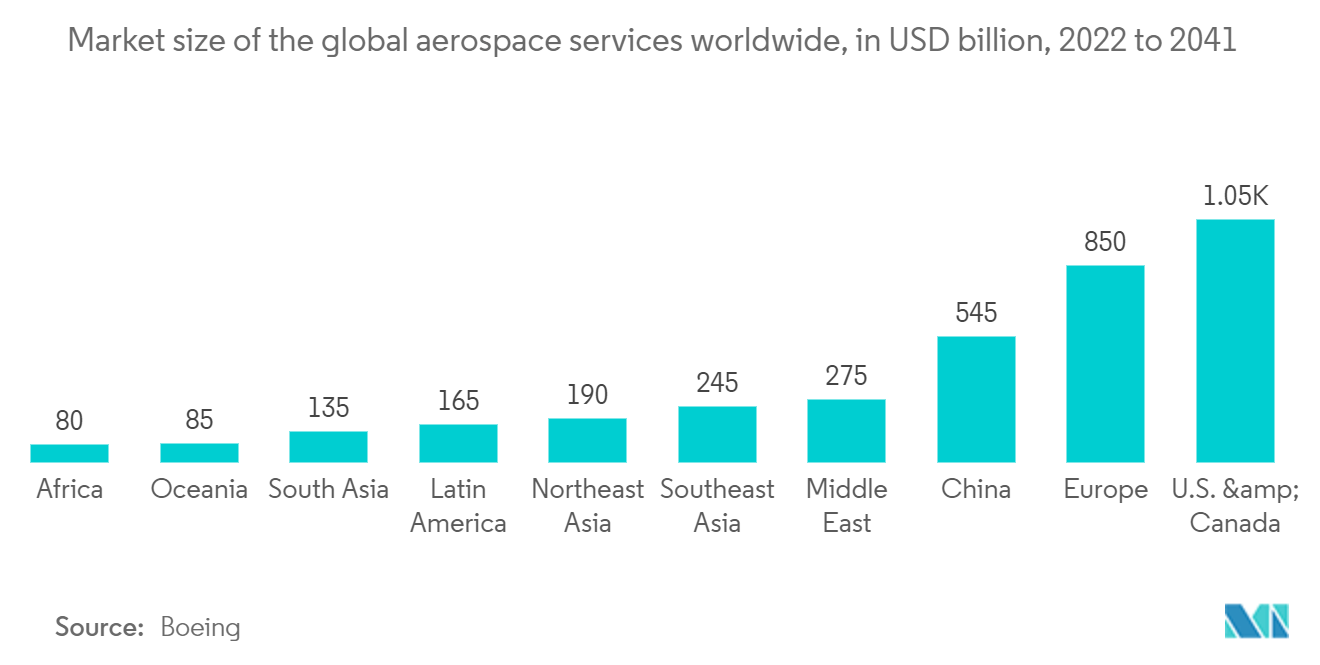
Asia Pacific to Hold Significant Share in Europe Region
- The Asia Pacific is home to the largest aerospace industry. According to IBEF, The Indian aerospace & defense (A&D) market is projected to reach USD 70 billion by 2030.
- Advanced vibration sensors are used for harsh applications, like aircraft rotor track and balance (RT&B). They also serve applications in aircraft design and testing, offering DC-response (static) and AC-response (dynamic) types of accelerometers.
- The growth of consumer electronics in the country has led to a rise in vibration sensors being integrated into appliances. Furthermore, according to the India Brand Equity Foundation (IBEF), the Indian appliances and consumer electronics (ACE) market is expected to register a 9% CAGR to reach INR 3.15 trillion (USD 48.37 billion) in 2022. This is expected to boost the vibration sensors market growth over the forecast period.
- In addition, the increase in demand for oil in the country is expected to lead to a rise in local refineries and exploration sites to fulfill the need, thus driving the demand for vibration sensors in the oil and gas industry.
- Manufacturing has emerged as one of the sectors showing high growth in the country. The country's Prime Minister's ambitious 'Make in India' program, meant to position India as a leading manufacturing hub and give global recognition to the Indian economy, is expected to drive the adoption of automation and smart technologies in the manufacturing sector.
- Furthermore, The Indian Oil Corporation, owned by the Central Government of India, announced its plans to invest INR 70,000 crore to further increase its oil refining capacity by 25% by 2030, as it takes the lead in meeting the rising energy needs of the country. Thus, such potential investments by other players (private) are poised to drive the vibration sensors demand in the country.
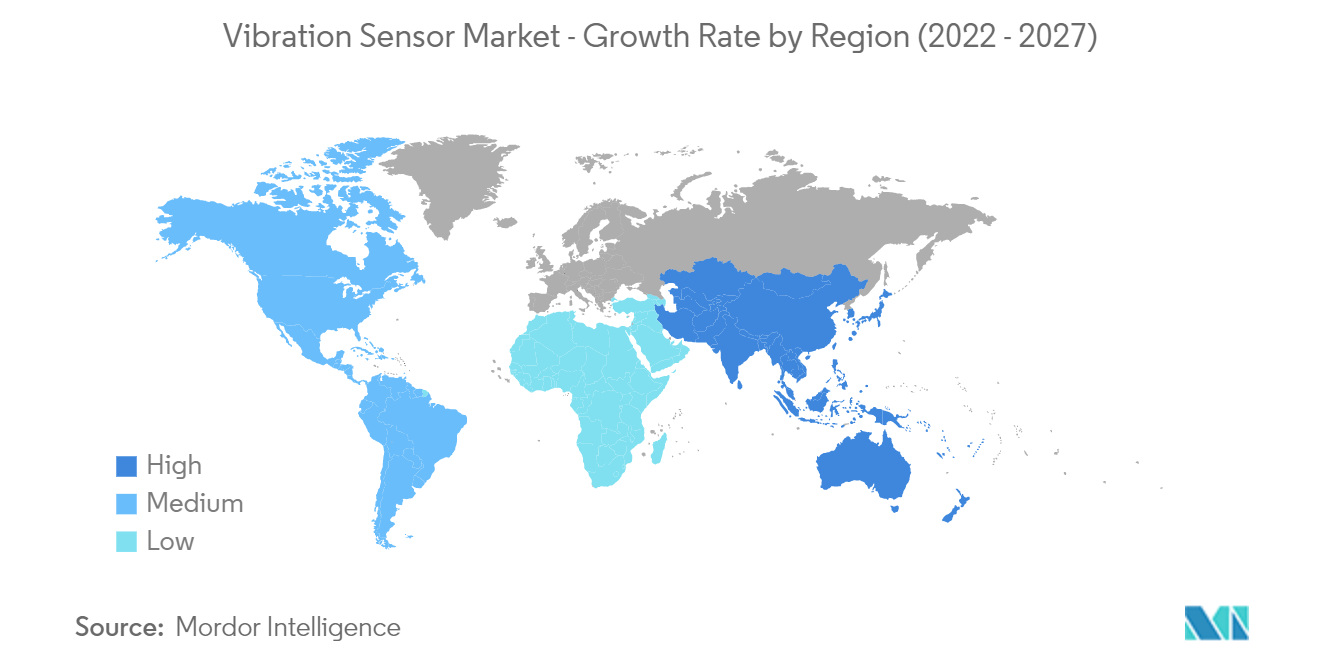
Vibration Sensor Industry Overview
The vibration sensor market is fragmented. The presence of global sensor manufacturers with established brand identities in the market is expected to profoundly influence the intensity of competitive rivalry as new entrants face challenges in reaching out to consumers. Brand identity plays a strong role in determining buyer behavior. Therefore, well-known companies have a considerable advantage over other players in the market. Some of the key players are Texas Instruments, Honeywell, and Emerson.
- October 2021 - TE Connectivity has launched three new products for the hybrid and electric commercial transportation market. The new IPT-HD power bolt connector performs in temperatures ranging from -40 to +125 degrees Celsius, and its low-contact-resistance design can withstand excessively high engine-level vibrations.
- May 2021 - STMicroelectronics has announced the release of the AIS2IH, a next-generation MEMS three-axis linear accelerometer. This accelerometer has the potential to improve temperature stability, resolution, and mechanical robustness in automotive applications such as telematics infotainment. The increasing integration of advanced technologies such as Artificial Intelligence (AI) and the Internet of Things (IoT) in vibration sensors opens up new market opportunities.
Vibration Sensor Market Leaders
SKF GmbH
Bosch Sensortec GmbH (Robert Bosch GmbH)
Honeywell International Inc.
Emerson Electric Corporation
Texas Instruments Incorporated
*Disclaimer: Major Players sorted in no particular order
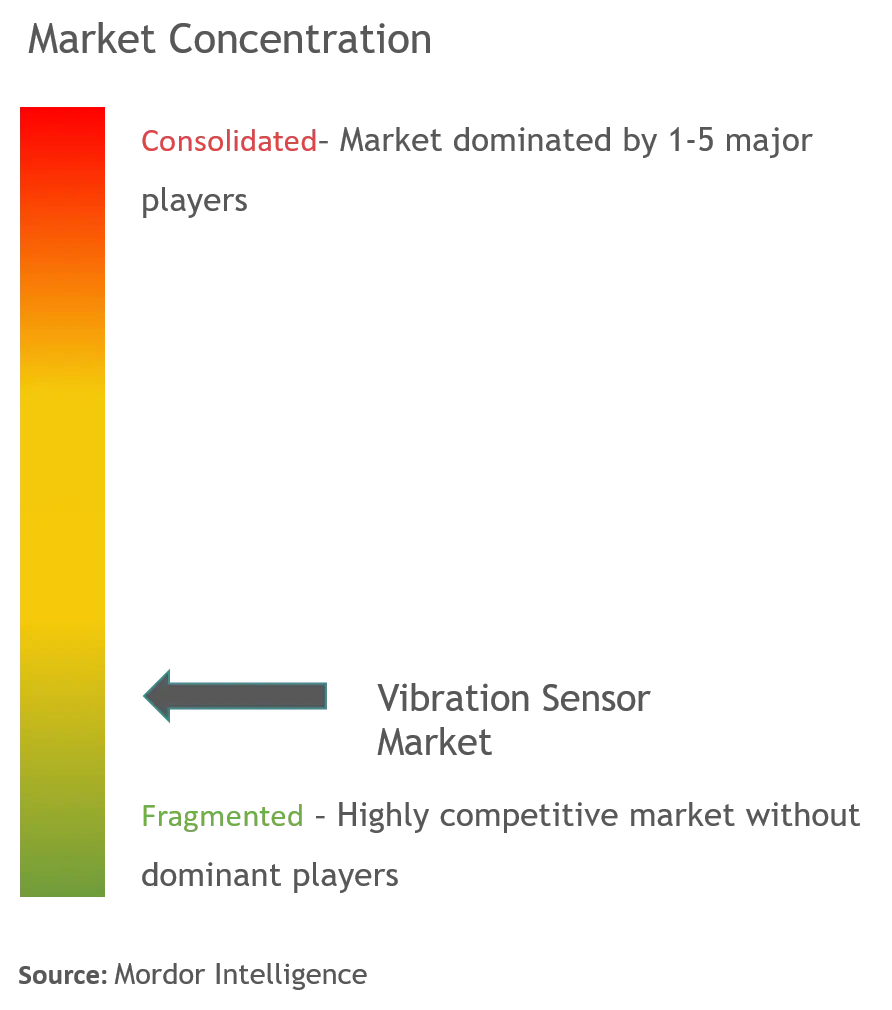
Vibration Sensor Market News
- May 2022 - Sensoteq announced Kappa X Wireless Vibration Sensor. The sensor features wireless technology, a replaceable battery design, and a fault detection capacity within a compact 25mm footprint, implying that it can be mounted on virtually any piece of rotating equipment in any industry.
- October 2021 - Renesas Electronics introduced the RAA2S425x family of integrated circuits. According to the company, the new devices will provide accurate amplification and sensor-specific correction of signals in automotive battery electric vehicles (BEVs), plug-in hybrid electric vehicles (PHEVs), and fuel-cell electric vehicles (FCEVs) for pressure-sensing braking, transmission, and HVAC systems.
- April 2021 - Honeywell has introduced a new line of miniature inertial measurement units that have been ruggedized to provide best-in-class accuracy and durability to withstand high-shock environments. The new HG1125 and HG1126 inertial measurement units (IMUs), roughly the size of a water bottle cap, are low-cost and serve both commercial and military applications. This new IMU family can withstand up to 40,000 G-force shocks, making it one of Honeywell's most durable IMU products to date.
Vibration Sensor Market Report - Table of Contents
1. INTRODUCTION
1.1 Study Assumptions and Market Definition
1.2 Scope of the Study
2. RESEARCH METHODOLOGY
3. EXECUTIVE SUMMARY
4. MARKET INSIGHTS
4.1 Market Overview
4.2 Industry Attractiveness - Porters Five Forces Analysis
4.2.1 Bargaining Power of Suppliers
4.2.2 Bargaining Power of Buyers
4.2.3 Threat of New Entrants
4.2.4 Threat of Substitutes
4.2.5 Intensity of Competitive Rivalry
4.3 Industry Value Chain Analysis
4.4 Assessment of Impact of COVID-19 on the Industry
5. MARKET DYNAMICS
5.1 Market Drivers
5.1.1 Increasing Need for Machine Condition Monitoring and Maintenance
5.1.2 Growing Adoption of Smart Manufacturing and Industrial IoT
5.2 Market Challenges
5.2.1 Volatility in Demand
6. MARKET SEGMENTATION
6.1 By Product
6.1.1 Accelerometers
6.1.2 Velocity Sensors
6.1.3 Non-contact Displacement Transducers
6.1.4 Other Products
6.2 End User Industry
6.2.1 Automotive
6.2.2 Healthcare
6.2.3 Aerospace and Defence
6.2.4 Consumer Electronics
6.2.5 Oil and Gas
6.2.6 Other End User Industries
6.3 By Geography
6.3.1 North America
6.3.1.1 United States
6.3.1.2 Canada
6.3.2 Europe
6.3.2.1 Germany
6.3.2.2 United Kingdom
6.3.2.3 France
6.3.2.4 Rest of Europe
6.3.3 Asia Pacific
6.3.3.1 China
6.3.3.2 India
6.3.3.3 Japan
6.3.3.4 Rest of the Asia Pacific
6.3.4 Latin America
6.3.4.1 Brazil
6.3.4.2 Argentina
6.3.4.3 Mexico
6.3.4.4 Rest of the Latin America
6.3.5 Middle East & Africa
6.3.5.1 United Arab Emirates
6.3.5.2 Saudi Arabia
6.3.5.3 South Africa
6.3.5.4 Rest of the Middle East & Africa
7. COMPETITIVE LANDSCAPE
7.1 Company Profiles
7.1.1 SKF GmbH
7.1.2 Bosch Sensortec GmbH (Robert Bosch GmbH)
7.1.3 Honeywell International Inc.
7.1.4 Emerson Electric Corporation
7.1.5 Texas Instruments Incorporated
7.1.6 National Instruments Corporation
7.1.7 Rockwell Automation Inc.
7.1.8 NXP Semiconductors NV
7.1.9 TE Connectivity Ltd
7.1.10 Hansford Sensors Ltd
7.1.11 Analog Devices Inc.
- *List Not Exhaustive
8. INVESTMENT ANALYSIS
9. FUTURE OF THE MARKET
Vibration Sensor Industry Segmentation
A vibration sensor is a device that detects and measures the amount and frequency of vibration in a system, machine, or piece of equipment. These measurements can detect asset imbalances or other problems and predict future breakdowns. Vibration monitoring and analysis are essential quality measurement phenomena in modern industrial infrastructure.
The studied market is segmented by Product Types such as Accelerometers, Velocity Sensors, and Non-contact Displacement Transducers among various Ends User Industries such as Automotive, Healthcare, Aerospace, Defense, Consumer Electronics, Oil and Gas, and multiple geographies. The impact of Covid-19 on the market is also covered under the scope of the study.
| By Product | |
| Accelerometers | |
| Velocity Sensors | |
| Non-contact Displacement Transducers | |
| Other Products |
| End User Industry | |
| Automotive | |
| Healthcare | |
| Aerospace and Defence | |
| Consumer Electronics | |
| Oil and Gas | |
| Other End User Industries |
| By Geography | ||||||
| ||||||
| ||||||
| ||||||
| ||||||
|
Vibration Sensor Market Research FAQs
What is the current Vibration Sensor Market size?
The Vibration Sensor Market is projected to register a CAGR of 7.30% during the forecast period (2024-2029)
Who are the key players in Vibration Sensor Market?
SKF GmbH, Bosch Sensortec GmbH (Robert Bosch GmbH), Honeywell International Inc., Emerson Electric Corporation and Texas Instruments Incorporated are the major companies operating in the Vibration Sensor Market.
Which is the fastest growing region in Vibration Sensor Market?
Asia Pacific is estimated to grow at the highest CAGR over the forecast period (2024-2029).
Which region has the biggest share in Vibration Sensor Market?
In 2024, the North America accounts for the largest market share in Vibration Sensor Market.
What years does this Vibration Sensor Market cover?
The report covers the Vibration Sensor Market historical market size for years: 2019, 2020, 2021, 2022 and 2023. The report also forecasts the Vibration Sensor Market size for years: 2024, 2025, 2026, 2027, 2028 and 2029.
Vibration Sensor Industry Report
Statistics for the 2024 Vibration Sensor market share, size and revenue growth rate, created by Mordor Intelligence™ Industry Reports. Vibration Sensor analysis includes a market forecast outlook to 2029 and historical overview. Get a sample of this industry analysis as a free report PDF download.
